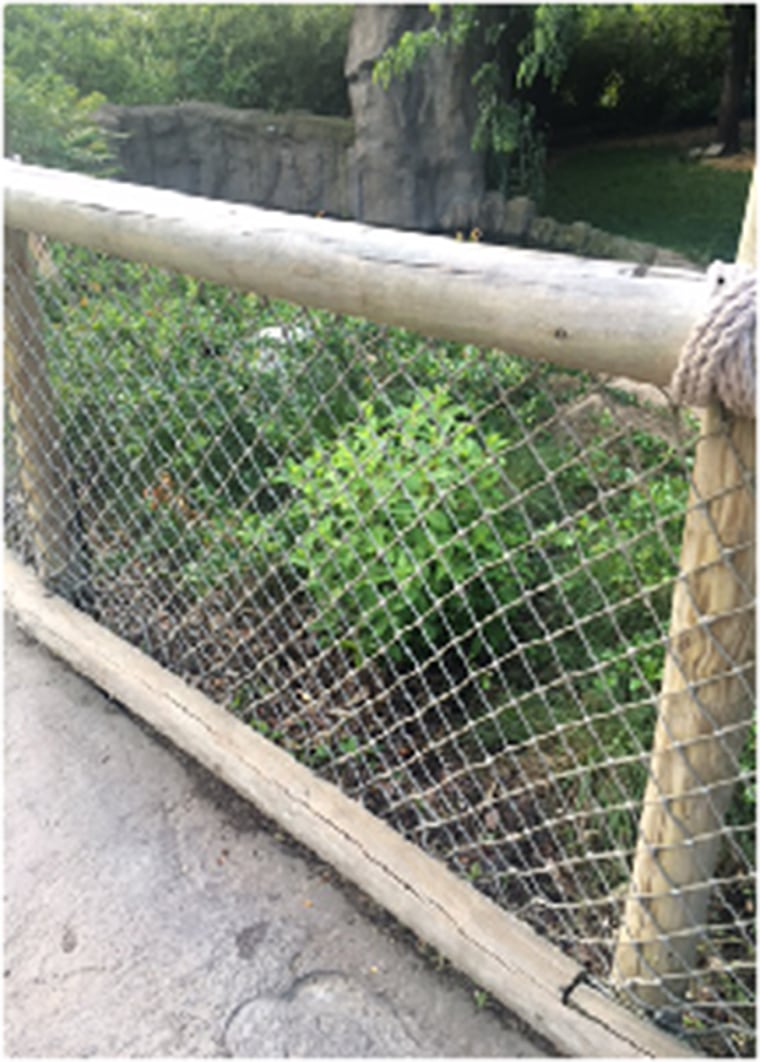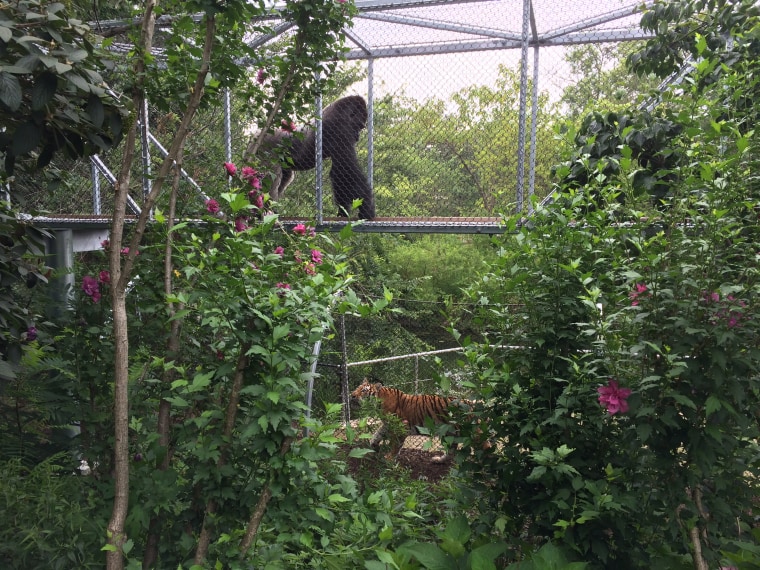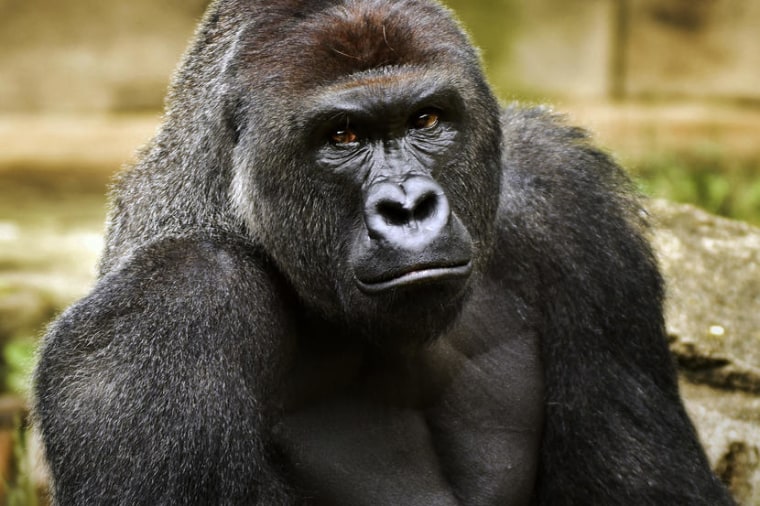When the Cincinnati Zoo reopens its gorilla enclosure on Tuesday, the exhibit's public barrier will be 3-1/2-feet tall — 6 inches higher than before — and will include a solid wood beam frame and knotted rope netting.
Zoo officials are counting on the redesign to help prevent a repeat of last week's scare, when a 3-year-old boy slipped underneath the barrier, pushed through brush and tumbled 10 feet into the enclosure occupied by a 450-pound gorilla named Harambe. Zoo employees shot the gorilla to death after it grabbed the conscious boy and dragged him into the corner of the attraction.

The adjustment of the fence height at the zoo's Gorilla World, which never before had a security breach since opening in 1978, highlights the delicate course that zoo designers must navigate to ensure that exhibits are comfortable for animals and stimulating to people — but also safe, experts and officials say.
"In recent decades, zoos have begun to redesign enclosures, removing all obvious caging in the attempt to create a seamless view of the animals in a more natural-looking habitat," former Knoxville zookeeper Amanda O'Donoughue explained on Slate.com after reaction to Harambe's shooting went viral on Facebook.
"This is fine — until little children begin falling into exhibits," she continued. "This of course can happen to anyone, especially in a crowded zoo setting."
Related: Listen to Mom's Frantic Call to 911 After Son Falls Into Gorilla Exhibit
While accidents can't always be avoided, the Association of Zoos and Aquariums (AZA) says that the rigorous requirements for a zoo to be accredited and maintain its standing is crucial to preventing dangerous situations for animals, workers and guests.
In addition, zoos are inspected for their upkeep twice a year by the U.S. Department of Agriculture.
The Cincinnati Zoo was recognized by the AZA last year for being continuously accredited for the past 25 years.
"All AZA-accredited zoos and aquariums are required to conduct four emergency drills per year, as well as have emergency procedures prepared for dangerous animals, like gorillas," association spokesman Rob Vernon told NBC News. "That preparation by Cincinnati Zoo led to prompt resolution of the incident last Saturday."
"It is also important to keep in mind that incidents like this are very rare, and zoos remain very safe places for families to visit," Vernon added.
A review of data on U.S. zoo-related accidents by Born Free USA, a nonprofit animal advocacy group, shows that 15 people have been killed by zoo animals from 1990 through 2016. Eleven of those were zoo employees, while four involved a park guest or someone who broke into the facility, according to the data.
{
"ecommerceEnabled": false
}The last death occurred in April in Palm Beach, Florida, when zookeeper Stacey Konwiser was killed when a Malayan tiger mauled her. The zoo said she broke protocol by entering the animal's enclosure.
The last non-worker death occurred in November 2012 at the Pittsburgh Zoo, where a 2-year-old boy fell into an exhibit of African painted dogs and was fatally mauled. One of the dogs was shot and killed.
Occurrences of animal-related injuries at U.S. zoos are more frequent — 93 since 1990 — according to Born Free USA, although that number represents just a tiny fraction of the 178 million-plus people who visit the parks annually.
{
"ecommerceEnabled": false
}The most recent injuries in the database include an inebriated woman who broke into a Nebraska zoo last November to pet a tiger and ended up with severe lacerations; a woman who climbed into a giraffe exhibit at a Wisconsin zoo in 2014 and was licked, then kicked by the animal; and a man who leaped from a moving monorail into a Siberian tiger exhibit at the Bronx Zoo in 2012. The man, initially thought to have been trying to commit suicide — or "zooicide" as it was labeled — was merely obsessed with the creatures, investigators said later.
While Born Free USA argues that animals such as gorillas don't belong in captivity, other than in sanctuaries, it says zoos that do care for wild creatures need to keep them as safe and as comfortable as possible.
Ian Redmond, chairman of the U.K.-based Ape Alliance and a Born Free USA consultant, said gorillas need to be surrounded by dense vegetation as opposed to sitting in "something like a goldfish bowl with humans looking in."
He said he's concerned about Cincinnati's Gorilla World because it allows humans to loom over the animals from above.
"It causes them stress," Redmond said, "but until this can be changed there must be numerous visual barriers to allow individual gorillas some privacy from the peering gaze of positionally dominant humans as well as from each other when feeding."
In spite of the latest accident, Cincinnati Zoo Director Thane Maynard lauded the gorilla exhibit for going "above and beyond standard safety requirements" and said the new higher barrier will "make entry even more difficult."
Zoo design consultant Michael Graetz said zoos began abandoning bar cages and simple slabs of concrete that once housed animals in the 1970s in favor of bigger lush habitats with netting and mesh fencing or sometimes glass walls — all intended to give viewers better access while giving the animals a semblance of their native habitat.
"It often takes a failure to reveal such flaws."
"We have to consider the safety of the animals as well as the people," Graetz said. "The animal should have no desire to escape if all its needs — physical and psychological — are met in the enclosure."
Cincinnati's Gorilla World is not covered or enclosed by glass, and includes a shallow moat.

Graetz cited the Philadelphia Zoo's use of aerial trails as an example of innovative design. The elevated walkways allow the animals to roam around the park and be seen while making physical contact with guests nearly impossible.
The Singapore Zoo, where Graetz previously worked, uses a canopy of trees in the orangutan enclosure to let the primates move freely around on a network of artificial vines — giving guests a more entertaining view and keeping the animals active.
While not every zoo has the financial capability to use such cutting-edge techniques, Graetz said, zoos and visitors need to work together to make as safe of an environment as possible.
Zoos are generally doing a good job of protecting people, he said, but the Cincinnati incident shows risks are inherent when humans are careless.
"While even one incident is too many, you can say it was pretty good going that (Cincinnati) had no incidents for 38 years," Graetz said.
But what happened with Harambe shows that no security scheme is infallible, he added.
"Since they found room for improvement, you could ask why they didn't (upgrade the barrier) before," he said. "It is just that it often takes a failure to reveal such flaws."

